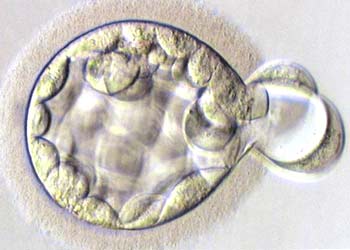Artificial insemination succeeds by hatching technique
In vitro fertilization center of Van Hanh Hospital (Ho Chi Minh City) has successfully applied in vitro fertilized embryo transfer thanks to hatching support technique.
On June 25, Dr. Ho Manh Tuong said a month after being transferred to a cold-treated cryopreserved embryo, 42-year-old NMP patient was pregnant. Previously, in 8 years, she was 6 times transferred embryos in vitro fertilization by conventional methods but failed.
According to Dr. Tuong, the hatching support technique has been successfully implemented in the United States since 1989, to thin the shell around the embryo, to help the embryo escape easily from the membrane and cling to the endometrium for nesting.

Embryos are preparing to escape from the thin "planed" shell. (Photo: TMH / VnExpress)
This technique is particularly effective for a number of difficult cases, in which many cases fail with in vitro fertilized embryo transfer despite good embryo quality and cold embryo transfer. In the world, this technique is also widely used to increase the rate of pregnancy fertilization in vitro.
Officially implemented in vitro fertilization technique from July 2007, up to now IVF Fertilizer Center has performed more than 50 IVF cases using techniques to support hatching embryos, with pregnancy rate above 40%.
- Speed up the process of developing artificial insemination
- 8 misconceptions about artificial insemination
- Artificial insemination - the reverse side of the miracle
- Rhino was born with the first artificial insemination method in the United States
- New techniques help increase the effectiveness of artificial insemination
- Artificial insemination for rhinos
- Japan successfully selected sex for artificial insemination rats
- He approached the fertilization from three people's DNA
- Koala was born with a new method of artificial insemination
- New artificial insemination method from human bone marrow
- Chinese artificial insemination for Siberian tigers
- Do not believe in artificial insemination and Clomid therapy
 Green tea cleans teeth better than mouthwash?
Green tea cleans teeth better than mouthwash? Death kiss: This is why you should not let anyone kiss your baby's lips
Death kiss: This is why you should not let anyone kiss your baby's lips What is salmonellosis?
What is salmonellosis? Caution should be exercised when using aloe vera through eating and drinking
Caution should be exercised when using aloe vera through eating and drinking